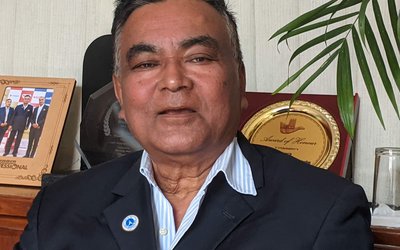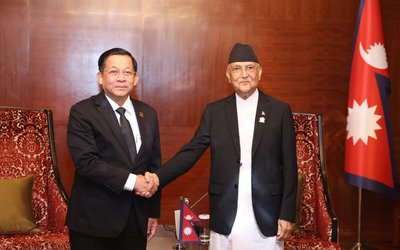
How do you see the launching of NAP?
This is a great occasion as we are launching another important program after NAPA. Given the large number of stakeholders at the launching program, I am more optimistic that we can really make a difference in the NAP process.
As Nepal already has NAPA, why does it need NAP?
As challenges of climate change are growing, there is the need to implement short-term and long-term adaptation programs in a country like Nepal. Nepal needs to implement the adaptation programs for a long time with strong commitment. As the 16th Cancun UNFCC had announced the plan to prepare National Adaptation Plan (NAP) for developing and Least Developed Countries looking at their particular needs, Nepal is now launching NAP process as per international requirements.
What is the NAP process?
The National Adaptation Plan (NAP) process helps countries conduct comprehensive medium- and long-term climate adaptation planning. It is a flexible process that builds on each country’s existing adaptation activities and helps integrate climate change into national decision-making. The Parties to the UNFCCC established the NAP process in 2011 in Durban. In 2012, a UNFCCC experts group developed a detailed set of NAP technical guidelines to assist developing countries, especially the least developed countries (LDCs), with adaptation planning.
What does NAP process emphasize?
As all other countries, Nepal’s NAP’s process will emphasize the Durban decision and technical guidelines. This process aims to integrate climate risk into national development planning, policies, and programs.
How do you integrate NAP with ongoing NAPA and LAPA?
As it is country specific, we have a lot of room to make it into our country specific plan. For instance, we have been successfully launching our NAPA and LAPA; we will develop a national planning process with outputs tailored to Nepal’s specific needs. As all of us know, medium- and long-term adaptation planning is a continual, ongoing process and it is for short term as the effects of climate change is long term.
How do you distinguish NAP and NAPA?
They are completely two different processes. For instance, our National Adaptation Programs of Action (NAPA) has somewhat different steps and UNFCCC established the NAPAs in 2001 to help the least developed countries address their most urgent and immediate adaptation needs. However, NAP is for both developing countries and LDCs.
Who will fund for NAP?
We have just launched the NAP. The launching was supported by Practical Action. We are asking various stakeholders to come to support other programs. As our secretary Dr. K.C. Paudel and UNFCC focal point has mentioned we seek support from all different stakeholders to make it as broad as possible.
How does the NAP process work?
Given Nepal’s experiences of making NAPA which is regarded as best documents, we can produce NAP process in time. Of course, it is a little bit different; the good part of the NAP is that its guidelines provide us broad flexibility to encourage planners to take only those NAP steps relevant to their country.
Has other organizations done some project to help NAP?
Jalshrot Vikas Sanstha (JVS) has already prepared two separate stocktaking reports on effects of climate change in agriculture and water resources sectors under NAP guidelines. Under the NAP global support program, training is conducted for Asia’s LDCs. Nepal took part in the regional level workshop organized by UNFCCC. The preliminary work is underway to help integrate the agriculture sector in NAP. Ministry of Health and Population has already started the program.
Since this is going to be a broader program, what plan does Ministry of Science, Technology and Environment has to coordinate with all different programs?
The Ministry will have a leadership role in the formulation of the NAP. The ministry is planning to constitute a technical committee for coordination and technical work. There will be all-subjective and inter-subjective working groups. The technical committee will be headed by focal point of UNFCC and joint secretary of Ministry of Science, Technology and Environment with members from different stakeholders.
How will the NAP be like?
The Ministry will have the leadership role. We will ensure gender sensitivity, participatory and transparency mechanisms in the process of preparation. We will follow the NAP process, selecting the subjects and inter subjects related working groups. We are constituting nine working groups in areas like agriculture and food security, forest and bio-diversity, water resources and energy, public health, climate induced disaster, urban settlement ad infrastructure, tourism, natural and cultural heritage. Similarly, there will be two cross-cutting working groups like in gender and protected communities under social inclusion and livelihood and good governance.
What has Nepal been launching under NAPA programs?
In the near future, the Ministry is implementing and catalyzing ecosystem restoration for resilient natural capital and rural livelihoods in degraded forests of Nepal. Reducing vulnerability and increasing adaptive capacity to respond to impacts of climate change and variability for sustainable livelihoods in agriculture sector in Nepal. Developing climate resilient livelihoods in the vulnerable watersheds in Nepal, ecosystem based adaptation for climate-resilient development in the Kathmandu valley and adapting to climate induced threats to food production and food security in the Karnali region of Nepal.
What benefits will Nepal get from implementing NAP?
As part of UNFCCC, it is an obligation of Nepal to implement it. The NAP process will help Nepal in many ways including, increasing the productivity and production in agriculture sector and sustainable use of development. It wills also be a continuation of implementation of adaptation program in Nepal.
Have other organizations also been involved in NAP process?
WWF and Clean Energy have already conducted interaction programs in Sindhupalchwok, Rasuwa, Itahari, Dhading, Pokhara and Kathamndu to collect the opinions on how to make the NAP process effective and coordinated. Technical guidelines of NAP and information about NAP have already been translated and published in Nepali.
What programs do you have to incorporate other's views?
Since the Ministry has experiences of preparing NAPA, we know the way to incorporate the views of all different stakeholders in the process. During the making of NAPA, we used a subjective approach and now we will prepare NAP using a scientific approach. We can also learn from our own and the knowledge of our neighbors. I am very proud that our LAPA is a model for different parts of the world on how to mobilize community in climate change program.
How do you see the process?
Nepal has already announced NAPA and is not implementing it yet. NAP is required to acquire further funding to implement the adaptation program. Although there is the need to implement NAP and then NAPA and LAPA, it is not late even now to prepare for this. Nepal released NAPA in 2010 and NAPA prioritizes nine sectors in adoption for immediate implementation. We have been implementing some of adaptation programs very successfully. As our adaptation programs are based on community and ecosystem, they are a model for the world. The National Adaptation programs follow the climate change policy under the Local Adoption Program of Action (LAPA).
- IME GROUP: Expands Into Paper Industry
- Mar 24, 2025
- CPN UML: Instigated By India
- Mar 23, 2025
- ADB’S CHIEF ECONOMIST: Nepal Reduces Poverty
- Mar 11, 2025
- FM DR. DEUBA: A Successful Visit
- Mar 11, 2025
- MD GHISING: Target Of Personal Grudge
- Mar 09, 2025















